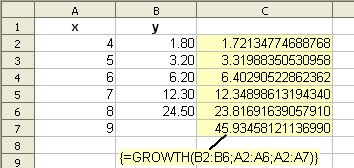Difference between revisions of "Documentation/How Tos/Calc: GROWTH function"
From Apache OpenOffice Wiki
< Documentation | How Tos
Javier Lopez (Talk | contribs) |
|||
| Line 54: | Line 54: | ||
<br style="clear:both;" /> | <br style="clear:both;" /> | ||
| − | {{ | + | {{SeeAlso|EN| |
* [[Documentation/How_Tos/Calc: TREND function|TREND]] | * [[Documentation/How_Tos/Calc: TREND function|TREND]] | ||
* [[Documentation/How_Tos/Calc: LOGEST function|LOGEST]] | * [[Documentation/How_Tos/Calc: LOGEST function|LOGEST]] | ||
Revision as of 08:40, 17 July 2018
CALC FUNCTIONS
